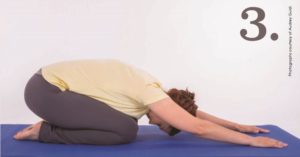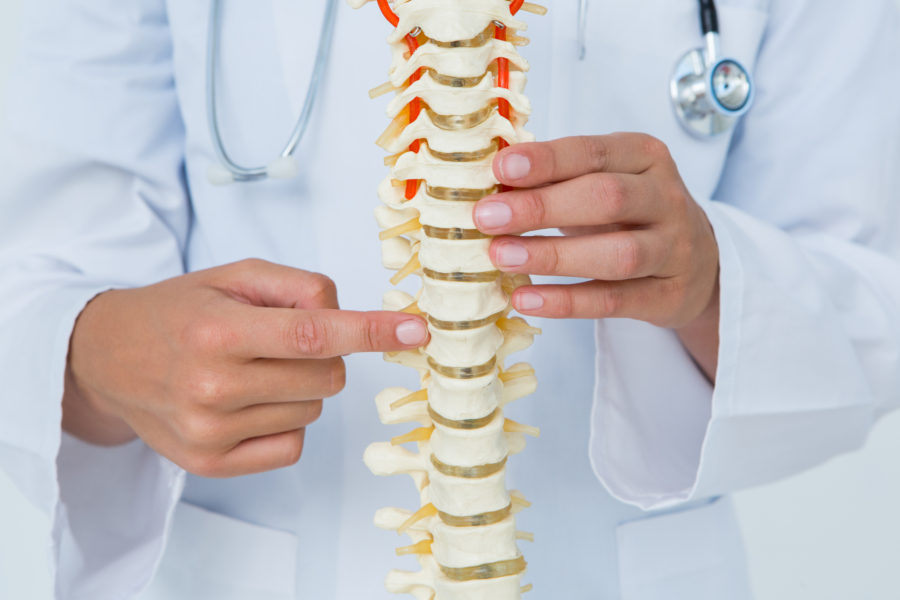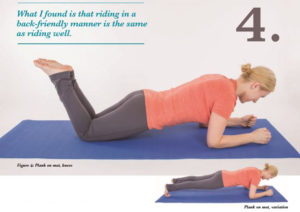Back pain seems fairly common in riders, but it doesn’t have to be that way. Understanding the factors that contribute to back pain, and learning exercises and strategies to prevent problems, may save you “down the road”.
An estimated 85% of adults will experience back pain at some time in their lives. For over half of them, the pain will recur. I speak from experience. About 20 years ago, my riding passion was put on hold due to severe back problems that required surgery. A practicing physician at the time, I had to figure out how to ride and take care of my horses. So I donned my “scientific” hat and learned the “back-friendly” way to ride. What I found is that riding in a back-friendly manner is the same as riding well. Before I address preventative options and helpful exercises any further, though, let’s take a closer look at the causes of back pain.
 The spine – the backbone of good health
The spine – the backbone of good health
The spine consists of a series of stacked vertebrae (Figure 1), each separated from the other by an intervertebral disc. The disc allows a small amount of movement between each vertebrae. Excessive movement and malalignment at the intervertebral and other joints of the spine are important contributors to back pain.
Risk factors for back pain
There are many risk factors for back pain, including cigarette smoking, depression, stress, jobs that require heavy lifting, twisting and bending, and even sedentary work, which can prove stressful to your back. Back health begins with examining your lifestyle. Are there aspects of your daily life that could be modified to limit the aforementioned risk factors?
Good posture is the natural alignment of your vertebrae. Preserving good posture requires an awareness of spine alignment and the muscular support of this alignment. The following exercises can help you become aware – and supportive – of your posture.
Exercise for spinal awareness
1. Supine pelvic rocking
Small movements of the pelvis and lower back improve awareness of spine alignment.
- Lie on the floor or a mat, knees bent, feet flat on the floor hip-joint width apart, in neutral alignment.
- Take an easy inhale breath.
- Posterior pelvic tilt or pelvic tuck – On the exhale, scoop in your abdominal muscles to move the top of your pelvis toward the floor, flattening your low back.
- Anterior pelvic tilt – On the next inhale, move the top of your pelvis away from the floor, arching your back slightly so your lower back comes off the floor.
- Slowly alternate flattening and arching your lower back six to eight times, inhaling as you arch your spine, and exhaling as you flatten your spine onto the floor. Try to use abdominal and back muscles for this movement, not your gluteal or leg muscles.
- Gradually decrease your range of motion until, like a pendulum moving slower and slower, your lower back comes to rest. This position is likely very close to your neutral spine alignment.
- When your spine is in neutral alignment, the plane defined by three points — your pubic bone, and the prominent bones on the right and left sides of the front of your pelvis – will be parallel to the floor. When you stand, or sit in the saddle, this plane is perpendicular to the floor.
Exercises for postural support
Once you have found correct spine alignment, you need to keep your spine in this position…despite being on a moving horse! Supporting good posture on horseback not only keeps your spine in a healthy position, but also provides the most efficient position from which to achieve balance.
2. Spine Extension
This exercise strengthens the muscles of your back.
- Lie on the floor on your stomach. Rest your forehead on a towel for comfort, if required.
- Place your arms by your sides with your palms up.
- Take an easy inhale breath. Exhale, and pull your abdominal wall up off the floor. This should not be a visible movement, just a pulling in of your abdomen to support your lower back.
- On the next inhale, bring your shoulder blades together and slowly lift your upper body off the floor. The muscles to lift your upper body should be the deep mid and upper back muscles (Figure 2).
- Exhale as you rest your upper body back down.
- Repeat four to six times.
Initiate the movement with your shoulder blades coming down your back toward the center of your body, and not from your neck. Feel that you keep your head and neck in alignment with the rest of your spine. Feel as if your back is getting longer, reaching away from your pelvis. If this exercise causes low back pain, reduce the range of motion and seek support from your scooped-in deep abdominal muscles, or avoid the exercise until you can get expert feedback. Follow this exercise set with a back stretch.
3. Back stretch
- Start on your hands and knees. Sit back toward your heels and lower your forehead toward the mat (Figure 3).
- Either reach your arms overhead, resting your hands on the floor, or keep them by your sides.
- Use your breath to stretch your back muscles. As you breathe in, feel how expanding your rib cage stretches your back muscles. As you exhale, focus on scooping in the abdominal muscles to support the stretch of your lower back muscles. Hold for several breaths.
- Walk your hands over to your right side, stretching the left side of your body. Breathe into the left rib cage two to three times to facilitate the stretch.
- Walk your hands over to your left side, stretching the right side of your rib cage.
4. Plank on mat: knees
Plank is a fantastic integrating exercise for core muscles function and shoulder and leg support.
- Lie on your stomach on a mat.
- Bend your elbows and keep them by your sides and place your forearms on the mat. Bend your knees so your lower legs are off the floor.
- While keeping your shoulders stable, lift yourself onto your knees and forearms into a suspended plank position. Seek a long and neutral spine position and avoid pulling your shoulders up around your ears. Try to keep your pelvis level, not pushed up to the ceiling.
- Hold this position for 30 to 60 seconds.
Plank exercises help integrate abdominal and back muscles, as well as the shoulder girdle and leg muscles. They encourage body stability and balance. When I see a rider being pulled or tossed around by her horse, I say: “Think plank!”
Preventing injury outside the saddle
We know to be mindful of our posture while in the saddle. However, back injuries can also occur while working around your horse. Pay attention to body alignment and mechanics during your barn chores. Remember the following:
- Avoid twisting while lifting.
- Lift objects by bending your legs, not your spine. Remember, “align your nose with your toes” to prevent twisting and strain.
- Move your feet to fork manure into the wheelbarrow — avoid rotating your torso.
- Keep heavy objects close to the front of your body.
- Split heavy loads into several lighter loads, or get help.
- Use a tractor or wheelbarrow whenever possible.
- Use a step stool to groom a large horse. Don’t reach and twist to get at his back.
- Finally, avoid fatigue! Just as with horses, injuries are more likely to occur when you’re tired.
Maintaining a healthy back involves lifestyle choices and attention to biomechanics both on and off your horse. Riding with good posture in a manner that supports your spine also creates body balance and control – essential to good riding!
Ride in balance, ride in support, and ride in good health.









